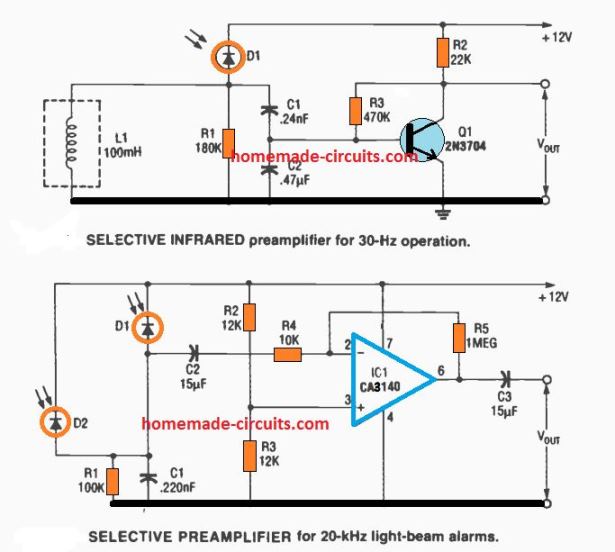- Get link
- X
- Other Apps
The current is generated when photons are absorbed in the photodiode. For the purposes of simplified analysis we can model a photodiode as an ideal non photosensitive diode in parallel with a light dependent current source.

Photodiode And 2n2222 Npn Bjt Light Dependent Switch Circuit

Light Sensor Using Ldr Photodiode And Phototransistor

Photodiode An Overview Sciencedirect Topics
Phototransistor circuit symbol for a device based around an npn transistor phototransistors can be based around both npn transistors and pnp transistors and therefore it is perfectly possible to have a pnp phototransistor and for this the direction of the arrow on the emitter is reversed in the normal way.
Npn photodiode. It works by allowing light to reach the pn junction of the device through the transparent opening. It is more or less proportional to the amount of incident light when vout voc. The output voltage vout is given as vout 1p rl.
Photodiode is in the class of photo junction device which is basically a pn junction light sensor. Photodiodes may contain optical filters built in lenses and may have large or small surface areas. It can also be compressed logarithmically relative to the amount of incident light when v out is near v oc.
Current produced by a photodiode without bias into a voltage. A photodiode is simply a pn silicon diode where light will generate a current proportional to light intensity on the pn junction depletion region. This reverse current can then be amplified by the bjt transistor.
V oc is the open terminal voltage of a photodiode. All semiconductor diodes are to some extent photodiodes but some are much more sensitive than others. Increased optical power causes a linear increase in reverse current through the device.
The photodiode is reversed biased where the cathode goes to a positive voltage and th anode goes to the negative side of the supply. They are generally made from semiconductor pn junctions and are sensitive to visible light and infrared light. This current source is quite linear.
Photodiodes usually have a slower response time as their surface area increases. Typically you want to use a photodiode in photoconductive mode with a bjt which means that the photodiode should have an external reverse bias. The emitter emits electrons into the base which controls the number of electrons the emitter emits.
The npn transistor is designed to pass electrons from the emitter to the collector so conventional current flows from collector to emitter. One of the major difference between the photodiode and the phototransistor is that the photodiode uses pn junction diode which converts the light energy into an electric current whereas the phototransistor uses the ordinary transistor npn transistor for the conversion of light into current. A photodiode is a semiconductor device that converts light into an electrical current.
When light is incident on a photodiode the electrons and holes are separated and will allow the junction to conduct. The phototransistor is generally in the form of a bipolar npn silicon transistor encapsulated in a cover with a transparent opening.

Activity Led As Light Sensor Analog Devices Wiki

Phototransistor And Photodiode Category
China Silicon Npn Photodiode 5mm Round Standard With Flange

Photodiodes And Other Light Sensors Analog Devices Wiki

Light Sensitive Photodiodes July 1969 Electronics World

Difference Between Photodiode Phototransistor With

Potential Barrier Height An Overview Sciencedirect Topics

Photodiode Phototransistor Working And Application

Photodiode Visible Light Switches Npn 2cu2b Qq Online Trading
Osa Germanium Wrap Around Photodetectors On Silicon Photonics

Difference Between Photodiode And Phototransistor Photodiode

Figure 5 From Analysis Of N P N Photodiode In P Well Cpd
- Get link
- X
- Other Apps
Comments
Post a Comment